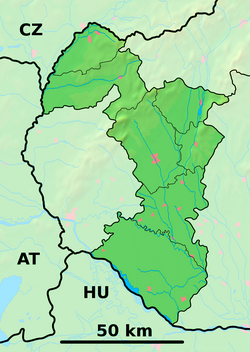Trnava | |
|---|---|
City | |
| Nickname: Malý Rím (Little Rome) | |
Location of Trnava in the Trnava Region | |
| Coordinates: 48°22′39″N 17°35′18″E / 48.37750°N 17.58833°E | |
| Country | |
| Region | Trnava |
| District | Trnava |
| First mentioned | 1211 |
| Government | |
| • Mayor | Peter Bročka |
| Area | |
| • Total | 71.54 km2 (27.62 sq mi) |
| (2022) | |
| Elevation | 144[2] m (472[2] ft) |
| Population | |
| • Total | 62,806 |
| • Density | 880/km2 (2,300/sq mi) |
| Demonym(s) | Trnavčan (m.) Trnavčanka (f.) (sk) |
| Time zone | UTC+1 (CET) |
| • Summer (DST) | UTC+2 (CEST) |
| Postal code | 917 00[2] |
| Area code | +421 33[2] |
| Car plate | TT |
| Website | trnava.sk |
Trnava (Slovak pronunciation: [ˈtr̩naʋa] , German: Tyrnau, German: [ˈtʏrnaʊ̯] ; Hungarian: Nagyszombat [ˈnɒcsombɒt], also known by other alternative names) is a city in western Slovakia, 47 km (29 mi) to the northeast of Bratislava, on the Trnávka river. It is the capital of the Trnava Region and the Trnava District. It is the seat of a Roman Catholic archbishopric (1541–1820 and then again since 1977). The city has a historic center. Because of the many churches within its city walls, Trnava has often been called "Little Rome" (Slovak: Malý Rím, Latin: parva Roma), or more recently, the "Slovak Rome".
- ^ Statistical Office of the Slovak Republic (www.statistics.sk). "Hustota obyvateľstva - obce". www.statistics.sk. Retrieved 2024-02-08.
- ^ a b c d "Základná charakteristika". www.statistics.sk (in Slovak). Statistical Office of the Slovak Republic. 2015-04-17. Retrieved 2022-03-31.
- ^ Statistical Office of the Slovak Republic (www.statistics.sk). "Počet obyvateľov podľa pohlavia - obce (ročne)". www.statistics.sk. Retrieved 2024-02-08.






